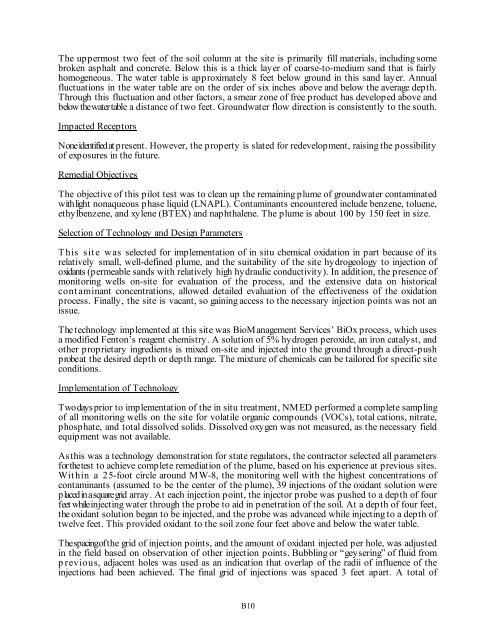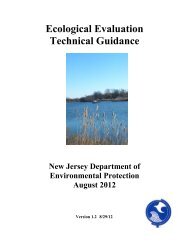Technical and Regulatory Guidance for In Situ Chemical ... - ITRC
Technical and Regulatory Guidance for In Situ Chemical ... - ITRC
Technical and Regulatory Guidance for In Situ Chemical ... - ITRC
Create successful ePaper yourself
Turn your PDF publications into a flip-book with our unique Google optimized e-Paper software.
The uppermost two feet of the soil column at the site is primarily fill materials, including some<br />
broken asphalt <strong>and</strong> concrete. Below this is a thick layer of coarse-to-medium s<strong>and</strong> that is fairly<br />
homogeneous. The water table is approximately 8 feet below ground in this s<strong>and</strong> layer. Annual<br />
fluctuations in the water table are on the order of six inches above <strong>and</strong> below the average depth.<br />
Through this fluctuation <strong>and</strong> other factors, a smear zone of free product has developed above <strong>and</strong><br />
below the water table a distance of two feet. Groundwater flow direction is consistently to the south.<br />
Impacted Receptors<br />
None identified at present. However, the property is slated <strong>for</strong> redevelopment, raising the possibility<br />
of exposures in the future.<br />
Remedial Objectives<br />
The objective of this pilot test was to clean up the remaining plume of groundwater contaminated<br />
with light nonaqueous phase liquid (LNAPL). Contaminants encountered include benzene, toluene,<br />
ethylbenzene, <strong>and</strong> xylene (BTEX) <strong>and</strong> naphthalene. The plume is about 100 by 150 feet in size.<br />
Selection of Technology <strong>and</strong> Design Parameters<br />
T his sit e was selected <strong>for</strong> implementation of in situ chemical oxidation in part because of its<br />
relatively small, well-defined plume, <strong>and</strong> the suitability of the site hydrogeology to injection of<br />
oxidants (permeable s<strong>and</strong>s with relatively high hydraulic conductivity). <strong>In</strong> addition, the presence of<br />
monitoring wells on-site <strong>for</strong> evaluation of the process, <strong>and</strong> the extensive data on historical<br />
cont aminant concentrations, allowed detailed evaluation of the effectiveness of the oxidation<br />
process. Finally, the site is vacant, so gaining access to the necessary injection points was not an<br />
issue.<br />
The technology implemented at this site was BioManagement Services’ BiOx process, which uses<br />
a modified Fenton’s reagent chemistry. A solution of 5% hydrogen peroxide, an iron catalyst, <strong>and</strong><br />
other proprietary ingredients is mixed on-site <strong>and</strong> injected into the ground through a direct-push<br />
probe at the desired depth or depth range. The mixture of chemicals can be tailored <strong>for</strong> specific site<br />
conditions.<br />
Implementation of Technology<br />
Two days prior to implementation of the in situ treatment, NMED per<strong>for</strong>med a complete sampling<br />
of all monitoring wells on the site <strong>for</strong> volatile organic compounds (VOCs), total cations, nitrate,<br />
phosphate, <strong>and</strong> total dissolved solids. Dissolved oxygen was not measured, as the necessary field<br />
equipment was not available.<br />
As this was a technology demonstration <strong>for</strong> state regulators, the contractor selected all parameters<br />
<strong>for</strong> the test to achieve complete remediation of the plume, based on his experience at previous sites.<br />
Wit hin a 25-foot circle around MW-8, the monitoring well with the highest concentrations of<br />
contaminants (assumed to be the center of the plume), 39 injections of the oxidant solution were<br />
p laced in a square grid array. At each injection point, the injector probe was pushed to a depth of four<br />
feet while injecting water through the probe to aid in penetration of the soil. At a depth of four feet,<br />
the oxidant solution began to be injected, <strong>and</strong> the probe was advanced while injecting to a depth of<br />
twelve feet. This provided oxidant to the soil zone four feet above <strong>and</strong> below the water table.<br />
The spacing of the grid of injection points, <strong>and</strong> the amount of oxidant injected per hole, was adjusted<br />
in the field based on observation of other injection points. Bubbling or “geysering” of fluid from<br />
p revious, adjacent holes was used as an indication that overlap of the radii of influence of the<br />
injections had been achieved. The final grid of injections was spaced 3 feet apart. A total of<br />
B10
















